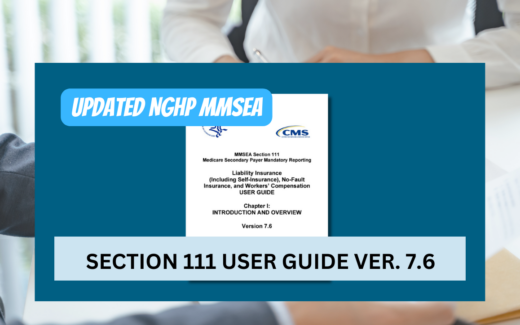On July 1st, 2024, the Centers for Medicare and Medicaid Services (CMS) released an updated version of the Non-Group Health Plan (NGHP) MMSEA Section 111 User Guide to Version 7.6. Ametros is committed to keeping our partners and industry stakeholders informed of critical updates that may impact their operations and compliance efforts involving CMS updates with Medicare Secondary Payer (MSP) reporting requirements. In this article, we highlight the key changes introduced in this latest update.
Enhanced Definition and Qualification of Cumulative Trauma
Chapter I – Introduction and Overview
This chapter now provides a more detailed definition and qualification of cumulative trauma. Found under “Introduction and Important Terms” on page 2-2, CMS elaborates on the nature of cumulative trauma injuries, differentiating them from acute injuries. It is important to note the distinction made between CMS’ definition and that of Workers’ Compensation.
Key Changes
| Version 7.5 | Version 7.6 |
|---|---|
| This CMS definition differs from the definition of that generally used by the insurance industry under specific circumstances. For the DOI used by insurance/workers’ compensation industry, see Field 13 of the Claim Input File Detail Record in the NGHP User Guide Appendices Chapter V | Note: Cumulative injury refers to those categories of injuries that may persist or grow in severity, intensity, or pain but for which a formal diagnosis may not occur until a later date. Examples of cumulative injuries include, but are not limited to, carpal tunnel syndrome, or back pain that is not the result of an acute trauma. Exposure, ingestion, and inhalation injuries are not considered cumulative injuries for purposes of calculating DOI or any other reporting requirements. This CMS definition differs from the definition of that generally used by the insurance industry under specific circumstances. For the DOI used by the insurance and workers’ compensation industry, see Field 13 of the Claim Input File Detail Record in the NGHP User Guide Appendices, Chapter V. |
DOI for Cumulative Trauma Clarified
Chapter V – Appendices: This chapter clarifies CMS’ stance on the DOI for cumulative, specifically in Fields 12 and 13.
Key Differences
- CMS Definition (Field 12): Defines the Date of Injury (DOI) for cumulative trauma under CMS guidelines as the dates of first exposure
- Workers’ Compensation Definition (Field 13): Defines the DOI as the date of last exposure
MMSEA Section 111 Medicare Secondary Payer Mandatory Reporting – Chapter V: Appendices 7.6
| Field | Description |
|---|---|
| CMS Definition (Field 12): | Date of Incident (DOI) as defined by CMS: • For an automobile wreck or other accident, the date of incident is the date of the accident. • For claims involving exposure (including, for example, occupational disease and any associated cumulative injury) the DOI is the date of first exposure. • For claims involving ingestion (for example, a recalled drug), it is the date of first ingestion. For claims involving implants, it is the date of the implant (or date of the first implant if there are multiple implants). • For claims involving cumulative injury, the DOI is the earlier of the date that treatment for any manifestation of the cumulative injury began, when such treatment preceded formal diagnosis; or the first date that formal diagnosis was made by any medical practitioner. Note: CMS’s definition of DOI generally differs from the definition routinely used by the insurance/workers’ compensation industry (Field 13) only for claims involving exposure, ingestion, or implants. Must be numeric and a valid date prior to or equal to the current BCRC processing date. Field cannot contain spaces, alpha characters or all zeroes. Format: CCYYMMDD Required. Note: Cumulative injury refers to those categories of injuries that may persist or grow in severity, intensity, or pain but for which a formal diagnosis may not occur until a later date. Examples of cumulative injuries include, but are not limited to, carpal tunnel syndrome, or back pain that is not the result of an acute trauma. Exposure, ingestion, and inhalation injuries are not considered cumulative injuries for purposes of calculating DOI or any other reporting requirements. |
| Workers’ Compensation Definition (Field 13) | Date of Incident (DOI) used by the insurance/workers’ compensation industry: For an automobile wreck or other accident, the date of incident is the date of the accident. For claims involving exposure, ingestion, or implantation, the date of incident is the date of last exposure, ingestion, or implantation. Note: The definition of DOI routinely used by the insurance/workers’ compensation industry DOI generally differs from the definition which CMS must use (Field 12) only for claims involving exposure, ingestion, or implants. Field must contain all zeroes or a valid date prior to or equal to the current BCRC processing date. Format: CCYYMMDD Optional. |
Understanding Cumulative Injury
It is crucial to understand the nature of cumulative injuries as outlined by CMS. These injuries are characterized by their persistence and potential to increase in severity or pain over time, even if a formal diagnosis is delayed. Examples include conditions like carpal tunnel syndrome or non-acute back pain. Notably, injuries from exposure, ingestion, and inhalation are excluded from being classified as cumulative injuries for the purpose of DOI calculation or reporting requirements.
Implications for WCMSA TPOC Reporting
Notably, CMS is enhancing the way it captures information on injuries that Medicare beneficiaries suffer via its mandatory Section 111 reporting. While these recent updates don’t directly impact the Medicare Set Aside (MSA) process, they are meant to provide greater clarity in the exchange of information between payors and Medicare so that when claims move toward settlement there will be closer alignment on the details and coding of the injury which may thereby assist with the MSA review process and subsequent reporting required after settlement.
Access the Updated User Guide
For more detailed information, we encourage you to review the full NGHP Section 111 Version 7.6 User Guide here.
For more information on NGHP DOI Field Definitions, you can review the MMSEA Section 111 Medicare Secondary Payer Mandatory Reporting NGHP User Guide, Chapter V: Appendices here. Ametros is here to help you navigate these updates effectively, ensuring you remain compliant with CMS Section 111 reporting updates and well-informed. For any questions or further clarifications, feel free to contact John Kane.


